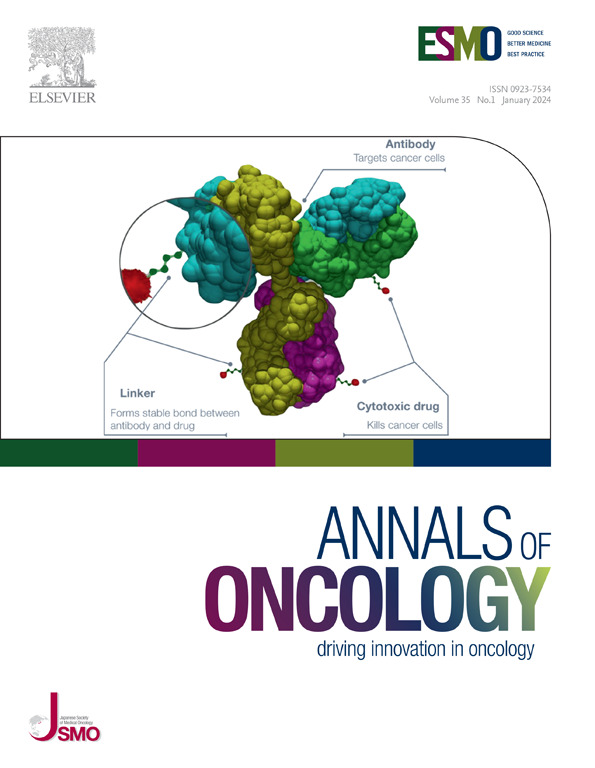II期I-SPY2临床试验中按临床和分子特征划分的HR+/HER2-高危早期乳腺癌(EBC)患者病理完全应答率(pCR)。
IF 65.4
1区 医学
Q1 ONCOLOGY
引用次数: 0
摘要
背景:激素受体阳性(HR+)、HER2-早期乳腺癌(EBC)是一种异质性疾病。确定更好的临床和分子生物标志物对指导每位患者的最佳治疗至关重要:我们分析了I-SPY2试验中8个新辅助治疗组中HR+/HER2- EBC患者的病理完全反应率(pCR)和无远处复发生存率(DRFS),并按临床/分子特征进行了分类:年龄、分期、组织学、ER阳性百分比、ER/PR状态、MammaPrint(MP)-High1(0至-0.57)与MP-High2(结果:379例HR+/HER2- EBC患者被纳入本次分析,观察到各治疗组的pCR率为17%。II期与III期疾病(21%对9%,P=0.0013)、导管组织学与小叶组织学(19%对11%,P=0.049)、较低%ER阳性率(≤66%对>66%)(35%对9%,p=3.4E-09)、MP-High2对MP-High1疾病(31%对11%,p=1.1E-05)、BP-基底型对BP-管腔型疾病(34%对10%,p=1.62E-07)以及ImPrint阳性对阴性疾病(38%对10%,p=1.64E-09)。ER%较低的患者更有可能患有MP-High2和BP-Basal型疾病。在中位 4.8 年的随访中,无论临床/分子特征如何,获得 pCR 的患者都有很好的预后。在未获得pCR的患者中,MP-High2和BP-Basal型疾病患者的DRFS事件发生率高于MP-High1和BP-Luminal型疾病患者:结论:在高分子风险HR+/HER2- EBC患者中,MP-High2、BP-Basal型和ImPrint阳性特征识别出了部分重叠的患者亚群,与MP-High1、BP-Luminal型和ImPrint阴性疾病患者相比,这些患者更有可能通过新辅助化疗+/-靶向药物或免疫疗法获得pCR。I-SPY2.2正在结合使用这些生物标记物,从分子上界定特定的患者群体并优化治疗选择。本文章由计算机程序翻译,如有差异,请以英文原文为准。
Pathologic complete response (pCR) rates for patients with HR+/HER2− high-risk, early-stage breast cancer (EBC) by clinical and molecular features in the phase II I-SPY2 clinical trial
Background
Hormone receptor-positive (HR+), human epidermal growth factor receptor 2 (HER2)-negative early-stage breast cancer (EBC) is a heterogenous disease. Identification of better clinical and molecular biomarkers is essential to guide optimal therapy for each patient.
Patients and methods
We analyzed rates of pathologic complete response (pCR) and distant recurrence-free survival (DRFS) for patients with HR+/HER2-negative EBC in eight neoadjuvant arms in the I-SPY2 trial by clinical/molecular features: age, stage, histology, percentage estrogen receptor (ER) positivity, ER/progesterone receptor status, MammaPrint (MP)-High1 (0 to −0.57) versus MP-High2 (<−0.57), BluePrint (BP)-Luminal-type versus BP-Basal-type, and ImPrint immune signature. We quantified the clinical/molecular heterogeneity, assessed overlap among these biomarkers, and evaluated associations with pCR and DRFS.
Results
Three hundred and seventy-nine patients with HR+/HER2-negative EBC were included in this analysis, with an observed pCR rate of 17% across treatment arms. pCR rates were higher in patients with stage II versus III disease (21% versus 9%, P = 0.0013), ductal versus lobular histology (19% versus 11%, P = 0.049), lower %ER positivity (≤66% versus >66%) (35% versus 9%, P = 3.4E-09), MP-High2 versus MP-High1 disease (31% versus 11%, P = 1.1E-05), BP-Basal-type versus BP-Luminal-type disease (34% versus 10%, P = 1.62E-07), and ImPrint-positive versus -negative disease (38% versus 10%, P = 1.64E-09). Patients with lower %ER were more likely to have MP-High2 and BP-Basal-type disease. At a median follow-up of 4.8 years, patients who achieved pCR had excellent outcomes irrespective of clinical/molecular features. Among patients who did not achieve pCR, DRFS events were more frequent in patients with MP-High2 and BP-Basal-type disease than those with MP-High1 and BP-Luminal-type disease.
Conclusions
Among patients with high molecular-risk HR+/HER2-negative EBC, the MP-High2, BP-Basal-type, and ImPrint-positive signatures identified a partially overlapping subset of patients who were more likely to achieve pCR in response to neoadjuvant chemotherapy ± targeted agents or immunotherapy compared to patients with MP-High1, BP-Luminal-type, and ImPrint-negative disease. I-SPY2.2 is incorporating the use of these biomarkers to molecularly define specific patient populations and optimize treatment selection.
求助全文
通过发布文献求助,成功后即可免费获取论文全文。
去求助
来源期刊

Annals of Oncology
医学-肿瘤学
CiteScore
63.90
自引率
1.00%
发文量
3712
审稿时长
2-3 weeks
期刊介绍:
Annals of Oncology, the official journal of the European Society for Medical Oncology and the Japanese Society of Medical Oncology, offers rapid and efficient peer-reviewed publications on innovative cancer treatments and translational research in oncology and precision medicine.
The journal primarily focuses on areas such as systemic anticancer therapy, with a specific emphasis on molecular targeted agents and new immune therapies. We also welcome randomized trials, including negative results, as well as top-level guidelines. Additionally, we encourage submissions in emerging fields that are crucial to personalized medicine, such as molecular pathology, bioinformatics, modern statistics, and biotechnologies. Manuscripts related to radiotherapy, surgery, and pediatrics will be considered if they demonstrate a clear interaction with any of the aforementioned fields or if they present groundbreaking findings.
Our international editorial board comprises renowned experts who are leaders in their respective fields. Through Annals of Oncology, we strive to provide the most effective communication on the dynamic and ever-evolving global oncology landscape.
 求助内容:
求助内容: 应助结果提醒方式:
应助结果提醒方式:


